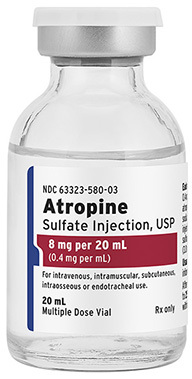1. What is the most important intervention to prevent the spread of infection in a hospital setting?
A. Proper hand hygiene before and after patient contact.
B. Properly disinfecting all medical equipment after each use.
C. Using personal protective equipment (PPE) when necessary.
D. Ensuring the patient is isolated if contagious.
A. Proper hand hygiene before and after patient contact.
2. Who defined nursing as “the act of utilizing the environment of the patient to assist him/her in his/her recovery”?
A. Virginia Henderson
B. Hildegard Peplau
C. Florence Nightingale
D. Dorothea Orem
C. Florence Nightingale
Atropine Sulfate

3. The above medication is frequently used in emergency situations to treat bradycardia. What is its mechanism of action?
A. Blocks dopamine receptors, increasing heart rate
B. Inhibits beta-adrenergic receptors, increasing heart rate
C. Inhibits muscarinic receptors, increasing heart rate
D. Stimulates nicotinic receptors, increasing heart rate
C. Inhibits muscarinic receptors, increasing heart rate
4. For a patient on traction, what is the most important action to ensure effectiveness?
A. Keep weights off the floor
B. Align traction with the deformity
C. Ensure ropes glide freely in the pulleys without any knotsD. Keep the patient centered on the bed
B) Align traction with the deformity
6. Why is a blood transfusion started at 20 drops per minute for the first 10 minutes?
A. To help the body adjust and prevent fluid overload
B. To detect early transfusion reactions for quick action
C. To prevent red blood cell hemolysis in kidney patient
D. To keep IV pressure steady and prevent clotting
B. To detect early transfusion reactions for quick action
7. Which of the following ECG characteristics is usually seen when a patient’s serum potassium level is 3.0 mEq/L?
A. Peak/tall T wave
B. Prominent U wave
C. Widened QRS interval
D. Flat P wave
B. Prominent U wave
8. Which of the following blood tests is most indicative of cardiac damage?
A. Lactate dehydrogenase
B. Complete blood count (CBC)
C. Troponin I
D. Creatine kinase (CK)
C. Troponin I
Bell’s palsy is a disorder of which cranial nerve?
A. Facial (VII)
B. Trigeminal (V)
C. Vestibulocochlear (VIII)
D. Vagus (X)
A. Facial (VII)